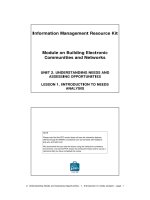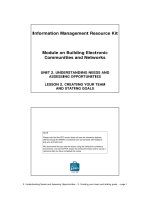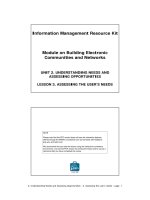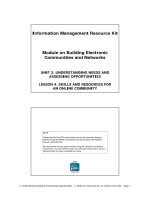UNIT 2. UNDERSTANDING NEEDS AND ASSESSING OPPORTUNITIES LESSON 4. SKILLS AND RESOURCES FOR AN ONLINE COMMUNITY doc
Bạn đang xem bản rút gọn của tài liệu. Xem và tải ngay bản đầy đủ của tài liệu tại đây (223.27 KB, 12 trang )
2. Understanding Needs and Assessing Opportunities - 4. Skills and resources for an online community - page 1
Information Management Resource Kit
Module on Building Electronic
Communities and Networks
UNIT 2. UNDERSTANDING NEEDS AND
ASSESSING OPPORTUNITIES
LESSON 4. SKILLS AND RESOURCES FOR
AN ONLINE COMMUNITY
© FAO, 2006
NOTE
Please note that this PDF version does not have the interactive features
offered through the IMARK courseware such as exercises with feedback,
pop-ups, animations etc.
We recommend that you take the lesson using the interactive courseware
environment, and use the PDF version for printing the lesson and to use as a
reference after you have completed the course.
2. Understanding Needs and Assessing Opportunities - 4. Skills and resources for an online community - page 2
At the end of this lesson, you will be
able to:
• recognize steps needed to assess
capacity of your organization and
stakeholders, and
• identify cost considerations to be
made at the assessment stage.
Objectives
Introduction
In this lesson we will discuss the capacity building assessment, one of the
needs analysis activities.
Needs assessment: assessing the needs of the potential online
community members
Capacity building assessment
Analysing technical, financial, institutional and social
barriers
Defining your idea: building up your team and identifying goals
2. Understanding Needs and Assessing Opportunities - 4. Skills and resources for an online community - page 3
What is capacity?
As you know, it is very
important to focus your needs
analysis so that you use your
time wisely and also answer
the right questions to know
how to build your online
community effort.
What is the capacity of you and
other stakeholders to build and
sustain an online community?
Do we have enough skills and
resources to carry out our
community building project?
When we talk about ‘capacity’ we
are referring to anything that
an individual, organization or
an entire community needs to
fulfill its goals.
It could mean either the skill or
time to handle activities such as
production of an electronic
newsletter, management of a
Web site, development of case
studies or simply logging on to an
online community Web site to
post a question for others to
answer.
What is capacity?
2. Understanding Needs and Assessing Opportunities - 4. Skills and resources for an online community - page 4
Since most online communities rely upon distributed responsibility to
share information and communications, it is helpful to think about
capacity on several levels.
What is the capacity of
other major partners to
market the online
community to their
communities?
What is your
capacity to
implement the
project?
What is the capacity of
leaders in the
community to stimulate
and facilitate the
generation of content and
conversation?
How to assess capacity
The Keper communication team is assessing the capacity to build and
sustain the online community…
How to assess capacity
Our first objective is to contribute to
extend information channels offered
by Keper.
See the interactive
lesson to have a
look at the Keper
objectives
Interaction technology
offers a large number of
channels that can be used
to let the members of a
group communicate and
exchange messages,
content and every kind of
knowledge.
Channels must be selected,
and the communication flow
must be created and
maintained.
2. Understanding Needs and Assessing Opportunities - 4. Skills and resources for an online community - page 5
How to assess capacity
• Production of a monthly electronic
newsletter
• Distribution of the monthly electronic
newsletter
• Development and maintenance of the
e-mail list of online community
members
• Archiving information on the Web site
ACTIVITIES
Choosing an electronic newsletter would involve
a series of related activities:
Imagine we choose to create an electronic
newsletter as an instrument to enhance
interaction.
What would this mean?
How to assess capacity
Who is
responsible?
Production of
a monthly
electronic
newsletter
What is the
capacity of the
stakeholder to
handle this
activity?
ACTIVITY
Let’s start from the first activity: who
would be responsible for the production
of a monthly electronic newsletter?
And what is his/her capacity to handle
this activity?
The Alfa Radio
station
The team identifies the Alfa radio station as
possibly being responsible for this specific activity.
2. Understanding Needs and Assessing Opportunities - 4. Skills and resources for an online community - page 6
How to assess capacity
The Alfa
Radio station
Who is
responsible?
Production
of a
monthly
electronic
newsletter
What is the
capacity of the
stakeholder to
handle this
activity?
ACTIVITY
The team has identified
the following capacity of
the selected stakeholder:
• they have excellent
writing skills, and
• they are well connected
to the community so they
should have no trouble
getting good content.
The major challenge they
will face is in formatting
the electronic newsletter
for text and html based e-
mail to community
members, and finding the
time to manage the
activity.
The Alfa Radio station
By doing this analysis, the team identifies the available resources in terms
of people, knowledge and skills, and the resources that still need to be
developed.
Can you summarize the method they use?
How to assess capacity
Put the steps in the correct order
Develop a list of activities
a
Identify who is responsible for
each activity
b
Identify the capacity of the
stakeholder to handle the activity
c
2. Understanding Needs and Assessing Opportunities - 4. Skills and resources for an online community - page 7
How to assess capacity
There are three primary ways to
gather information about the
capacity of an individual,
organization or community:
1) look at the past habits and
performance of the stakeholder in
question,
2) ask the stakeholder what they
think their capacity is to handle the
specific activity,
3) ask others who work with the
stakeholder in question about their
capacity.
How to identify the capacity of stakeholders in a realistic way?
You should start by looking back at the information gathered during other
assessment activities to review what the needs are of the online community
members and others involved in the effort.
Capacity of individuals and small organizations
Particularly for very small
organizations with 3 or 4
employees, or for individuals who
are leading an online community
building effort, building and
sustaining an online community
can be a daunting activity.
Along with the many questions
you decide to answer by collecting
information from your potential
online community members, there
is a specific set of questions
related to your capacity that
you must answer before moving
forward with the building of your
online community.
2. Understanding Needs and Assessing Opportunities - 4. Skills and resources for an online community - page 8
Questions to be answered include:
• How can you engage other people to fill in for you?
•What training needs will these other people have?
• Is there a single person who can back you up and
operate as second in charge of the online community?
• What will happen if you have to permanently leave
your role as a leader of the online community?
•What time constraints do you have that will
prevent you from handling your online community
building responsibilities?
•Are there particular times of day, the week,
month or year where your capacity changes?
• How will this affect your ability to handle the
ongoing needs of the online community?
Capacity of individuals and small organizations
Considerations about costs and time related to the
building and maintenance of the online community will
be an important part of your planning effort.
Is the assessment stage the time to think about them?
With which of the following opinions do you better
agree?
We should begin to budget for the project: costs for
hardware, software and various activities…
At the moment we should only consider costs for hardware
and software we will use.
It is not yet the time to think about costs: we should
consider them in the planning stage.
Click on the answer of your choice
The total cost of use
2. Understanding Needs and Assessing Opportunities - 4. Skills and resources for an online community - page 9
During the capacity building
assessment it is helpful to look
back at the data you gathered to
develop a general sense of cost
areas, and a list of these. We call
this “total cost of use” (TCU).
The total cost of use includes
both the time and financial
cost.
Combining the financial and
human resources necessary in
each of the categories listed will
give you a sense of the total cost
of use of your online community.
The following are some of the cost
areas the TCU can cover.
See next screens to learn more.
ConnectivityTechnical
Support
HardwareTraining
SoftwareAssessment &
Planning
TCU – Cost Areas
The total cost of use
Assessment & Planning
• Hiring consultants to help you do assessment and planning.
• The time of the team members and yourself to do assessment and planning.
• The time of any stakeholders who you are gathering information from.
• Planning for general implementation and maintenance of the online community,
privacy issues, security and other concerns.
• Marketing efforts both through electronic and non-electronic means to solicit
participation.
Training
• Hiring training specialists to develop any training curriculum you need, do training
assessment and/or development of a training plan.
• Hiring trainers to conduct training.
• Bartering cost related to partnerships you form to deliver training.
• The time you yourself might need to get trained or conduct training.
• The time of those being trained - key stakeholders as well as those who take a
leadership role. Training may be needed on the use of online tools like e-mail discussion
lists, content posting tools, facilitation or moderation and content development.
Technical Support
• Technical support related to planning, training, tool purchasing, maintenance,
marketing, etc. This is often provided by skilled community members in a volunteer or
paid capacity. It could also include consultants or other organizations with expertise that
does not exist in your organization or community.
The total cost of use
2. Understanding Needs and Assessing Opportunities - 4. Skills and resources for an online community - page 10
Software
• Purchasing of software tools for e-mail management, blogs and other online
community functionality you need to provide
• Operating system software
• Content management software
• Database software
• Virus protection software
• SPAM prevention software
•Web site software
• Digital video and/or photo imaging and editing software
Hardware
• Scanner
• Digital Camera
•Server
•Desktop terminals
•Handheld computers
•Cell phones
• Replacement/upgrade of hardware
Connectivity
•Web hosting
• Wiring needed to bring sites online
• Wireless tools
• Internet connectivity. Any online community relies on the Internet as the backbone of
information sharing and communications. Whoever hosts the online community tools will
need to provide adequate bandwidth.
The total cost of use
• begin to list the resources
you will need,
• begin to budget for the
project,
• generate questions you need
to answer,
• identify people or resources
you need to get more
information from, and
• allocate responsibilities to
keeps the TCU budgeting
process moving forward.
Thinking about the costs is helpful as the assessment process is not just
about gathering data, but also getting stakeholders invested in the
project.
You should have discussions with them in order to:
The total cost of use
2. Understanding Needs and Assessing Opportunities - 4. Skills and resources for an online community - page 11
From the interactive lesson you can download and print documents
that can help you in your work.
Online Community Capacity Building
Assessment form
Use this form to structure your information
gathering.
TCU discussion form
Hold a discussion with your team and
use this form to analyse the
implications of TCU for your project.
Job aids
Summary
“Capacity” is referred to as anything that an individual, organization or an
entire community needs to fulfill its goals.
Capacity includes skills, human resources, time and costs required to set
up and maintain the online community.
Capacity assessment can be carried out by following these steps: review
the goals, identify the relevant activities, identify who will be responsible
of each activity and determine his/her capacity to handle the activity.
Particularly for very small organizations or individuals, the capacity to
handle the project must be carefully checked.
Even if detailed budgeting will be part of the planning stage, at the
assessment stage it is very helpful to develop a general sense of all the
costs for the project.
2. Understanding Needs and Assessing Opportunities - 4. Skills and resources for an online community - page 12
• Managing the Mosaic, Winter 2003 Carl Sussman – Nonprofit
Quarterly Volume 10, Issue 4,
/>• The Management Assistance Program for Nonprofits Free
Management Library, Capacity Building Section
/>• ONE Northwest Activists Toolkit
/>• ASSESSMENT TOOL: ICT & development- help or hindrance?
/>Contains two sets of assessments tools for ICT-driven project or
mainstream development project w/ICT support.
If you want to learn more …









